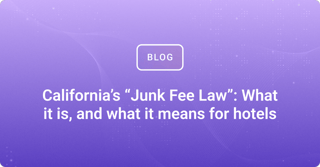In July 2024, the California Junk Fee Law was passed with the goal of eliminating the confusion surrounding hidden fees in the hospitality industry. This legislation requires hotels and other hospitality players to provide transparent pricing upfront, with mandatory add-ons like resort fees included in the advertised price.
While hotels now need to show resort fees upfront, that doesn’t mean there’s only one way to do so. We took a look at twelve different hotel booking engines to see how hotels are displaying their prices and fees — this is what we found.
Breaking out fees within the room selection page
Since it’s the key moment when guests choose what to book with you, and how much they’ll be spending, the way that you display fees on the room selection page is very important. As such, it’s a part of the booking flow where different hotels are making very different decisions.
When choosing a room on some sites, guests can see the price “including all fees” (but presumably excluding taxes, which is not explicitly highlighted. Especially if you’re dealing with international customers, we wouldn’t advise this messaging — for certain guests, seeing that added tax at the end without warning could lose you the booking.
.png?width=539&height=149&name=image%20(10).png)
.png?width=574&height=232&name=image%20(11).png)
On the other hand, some hotels opt to show a similar breakdown — but explicitly state that the price is “before taxes”, or "excluding taxes". This helps to manage guest expectations, and lets them know that government fees will be added on top of the rate shown.
.png?width=481&height=224&name=image%20(12).png)
.png?width=536&height=118&name=image%20(13).png)
To be a bit more transparent, it’s wise to highlight that the “fees” included are resort fees, as many hotels have opted to do.
.png?width=338&height=241&name=image%20(15).png)
This hotel goes a step further, underlining the resort fee line for emphasis and even linking to an overlay that gives more information on what the fee includes. .png?width=513&height=199&name=image%20(14).png)
.png?width=826&height=690&name=image%20(28).png)
In the name of full transparency, we’d also recommend including the cost of the resort fee in the room breakdown, as it provides guests with the relevant information upfront. Plus, it prohibits surprises down the line that could cause friction, potentially leading a guest to abandon the booking journey.
.png?width=629&height=183&name=image%20(16).png)
.png?width=635&height=268&name=image%20(17).png)
Incorporating resort fee messaging, right from the start
While the rate breakdown pages are important, hotels can make decisions all throughout the booking journey to improve their fee messaging. Starting from the very beginning of the booking flow, hotels start to take slightly different approaches. One hotel we looked at actually kicks off their customer’s journey with a pop-up highlighting that resort fees are now included in their upfront prices.
.png?width=1200&height=377&name=image%20(4).png)
There are a lot of benefits to this strategy. It provides clear messaging to the guest, and also highlights compliance with the new Californian law. They’ve also provided messaging around taxes — guests have the option to view their full room rate including taxes, so they can understand the real cost of their stay. However, it does add an extra step to the booking journey, as guests have to exit out of this screen to continue booking their stay.
Pricing breakdowns within date selectors
Some hotels are extremely clear in their pricing breakdown before customers have even entered the booking flow. This hotel, for example, highlights the room cost, the resort fee, and the total average per night, as well as making it clear that taxes are excluded, right within the date selector.
.png?width=787&height=907&name=image%20(5).png)
Other hotels opt to show only the total price with no fees broken out within the date selector, with messaging further down highlighting that these prices include all fees. In this situation, it’s less obvious how much guests are actually paying for the resort fee — and they could still be surprised by the final taxes added..png?width=830&height=703&name=image%20(6).png)
-1.png?width=758&height=583&name=image%20(7)-1.png)
Going one step further, some hotels surveyed don’t include any messaging at all at this stage (even though resort fees are included). This makes it a bit less clear to guests what’s actually included, but could simplify the guest-facing price and avoid them becoming confused by messaging around “resort fees”, “fees”, “fees excluding taxes”. In our opinion, too much information is better than too little -- so we'd recommend adding more details here.
.png?width=773&height=418&name=image%20(29).png)
One very important thing for hotels to bear in mind is to keep messaging consistent throughout the booking flow. We found one hotel where the date selector messaging hasn’t been updated and still says that rates were exclusive of taxes and fees — while in fact, one step along made it clear that the advertised rate did include the mandatory fees. This hotel looks as though it isn’t complying with the new law, when in fact it is.

.png?width=424&height=351&name=image%20(9).png)
Displaying fees and taxes at checkout
Right through to the final steps of booking, hotels continue to make different decisions in how to display their rates.
The most common display we saw was including a blanket “taxes and fees” amount within the booking flow, with a dropdown option to allow guests to see further details. This offers a clean, easy way for guests to understand where there money is going. Here are a couple examples of this.
.png?width=404&height=353&name=image%20(19).png)
.png?width=435&height=506&name=image%20(20).png)
.png?width=269&height=454&name=image%20(21).png)
Some hotels also opt to display a basic price breakdown upfront, with a more detailed pop-up option — which is what this hotel decided on. This allows hotels to give full transparency to the guest without crowding their checkout page, but has the negative of taking guests away from the direct booking flow.
Outlining the value of resort fees
Throughout the booking process, we noticed that a lot of the hotels we surveyed are using messages throughout their site to communicate what their resort fee includes. We think this is a great idea — after all, there’s a reason hotels are charging these fees. Why not be more transparent about that with guests? Many resort fees do, in fact, add a lot of benefit.
Some hotels used this messaging right at the top of the guest booking funnel.
.png?width=765&height=131&name=image%20(24).png)
Above the room selection options for a different hotel, you can see all the amenities that bookers will receive from being guests at this hotel — in this case, with a monetary value attached.
.png?width=856&height=241&name=image%20(25).png)
Another hotel offered details about their resort fees directly in their room selection modules. If a guests clicks on “amenities and description”, a dropdown opens with all of the amenities included in the resort fee.
.png?width=912&height=495&name=image%20(26).png)
.png?width=1188&height=393&name=image%20(27).png)
This is something that’s worth considering for any hotel. No one likes paying extra, but providing a bit more insight into the value that the fee provides can only help. Even if the fee just covers the operating expenses of amenities that may seem standard, it’s still worth highlighting a hotel’s fitness center, free water in rooms or ultra-helpful concierges. And if it can help to highlight some really fun extras (like bike rentals or a fun kid’s scavenger hunt) then all the better.
The shift toward transparency in hotel bookings - and what you can do to adapt
The new California junk fee law has driven significant changes in how hotels present their pricing, with many opting for more transparent practices. However, as we've seen, that approach can vary. Some hotels excel at providing clear, upfront information when it comes to fee and tax breakdowns, while others are doing a great job of highlighting the value of resort fees to their guests. There are a few things we’d suggest to hotels looking to improve the way they incorporate fees and taxes into their booking flow:
- Make taxes and fees easy to understand: When considering different ways to present pricing throughout the booking flow, it’s important for hotels to not only comply with the law, but consider what their guests may be looking for. For example, if your area has a lot of regional taxes and fees that confuse even locals, it may be a better idea to group those into one “taxes” category.
- Consider your competition: Have a look at local competitors. Do they typically have resort fees? If so, it’s essential to have your resort fees are clearly highlighted to avoid any disgruntled guests. On the other hand, if they don’t, you may want to think about incorporating more messaging around the value of your amenities (and why you have a resort fee.)
- Be transparent: The law is the law, and hotels obviously need to comply. However, the spirit of the law is to give guests more control and clarity when making bookings, and that’s something that hotels should also strive towards. Adding detailed breakdowns throughout the booking journey helps guests to understand the costs of their booking and feel empowered, which can lead to a better guest experience.
Hotels that embrace this shift toward transparent pricing not only comply with laws and regulations, but can also build stronger trust with their guests, ensuring a smoother booking experience with no last-minute surprises.
Get in touch with our experts today for more tips on how to improve your booking journey and drive more direct bookings.
Genevieve is a product marketing manager at Triptease.
.png?width=393&height=511&name=image%20(22).png)
.png?width=595&height=361&name=image%20(23).png)








